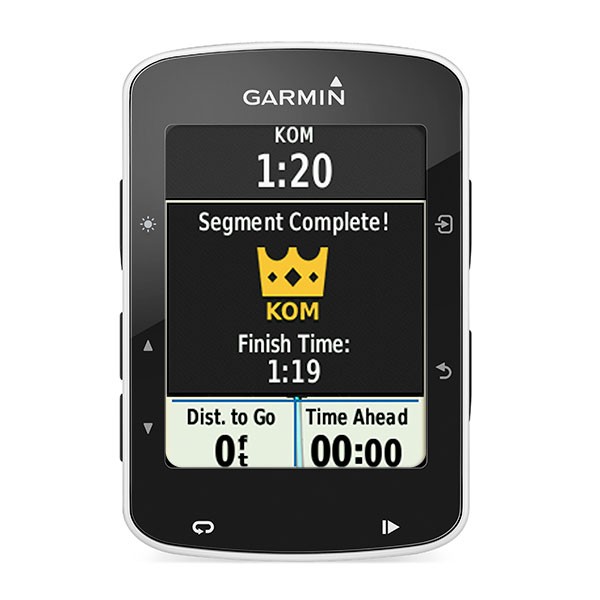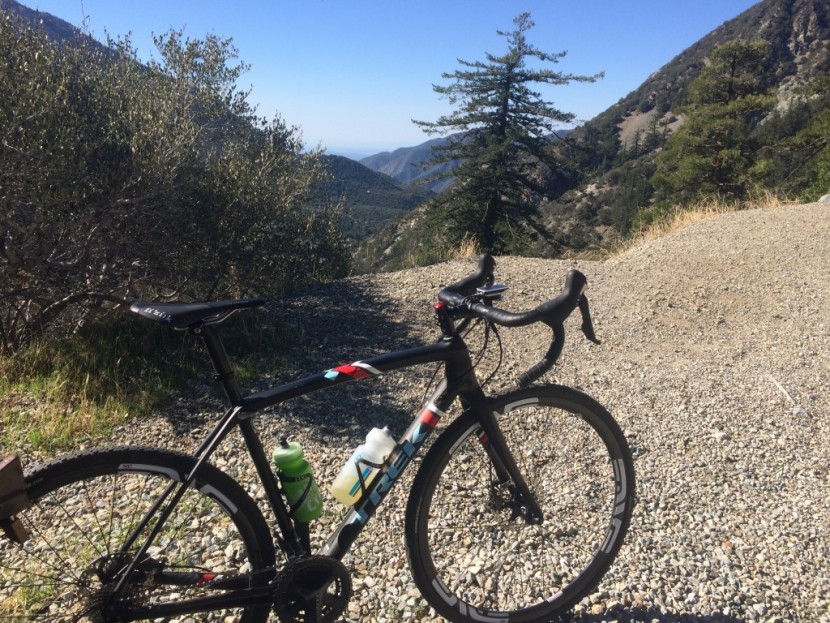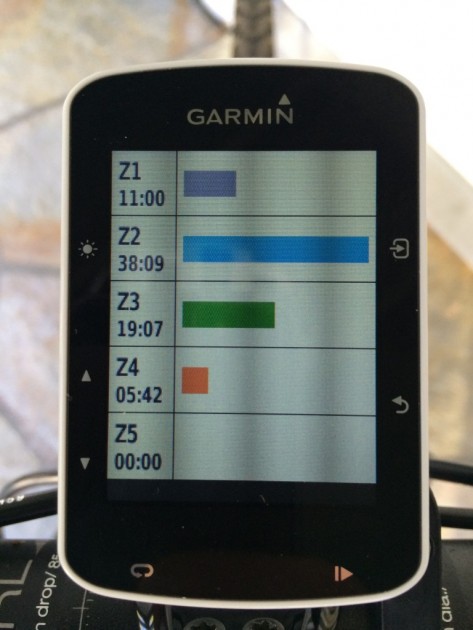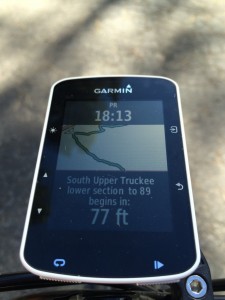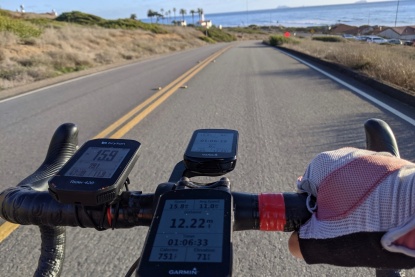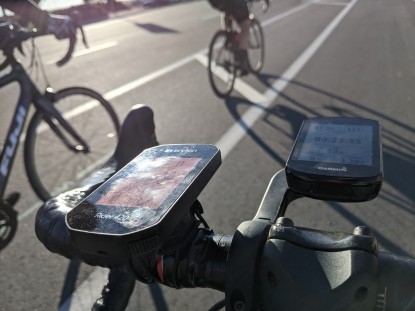This is Garmin's latest cycling computer. It is loaded with features and is the winner of our Top Pick Award for Strava addicts and racing. It has many parallel functions to the Garmin Edge 810 but lacks the touchscreen and routable maps of our Editors' Choice Award winner, the Edge 820. The Edge 520 is loaded with features, including Strava Live, which gives you real-time data on how close you are to stealing that KOM.
Like the 820 and its predecessor the 510, data uploads can be accomplished using the Garmin Connect Application. However, the 520 takes connectivity to the next level with Bluetooth 4.0, which allows you to get calls, text, and email updates sent to the device from your phone. If you are looking for the most advanced training tool available, with the added benefit of connectivity features, then the Edge 520 is the cycling computer for you.Garmin Edge 520 Review
Our Verdict
Our Analysis and Test Results
The Edge 520 by Garmin was released in July of 2015 and was the first device on the market to utilize the new Strava Live feature. (Strava Live is now available on the Edge 820, 1000, and 520.) Aimed at being a replacement for the long-popular Garmin Edge 500, the past winner of our Best Buy Award, the Edge 520 has a simple tactile button interface. Make no mistake; the Edge 520 is leaps and bounds ahead of its predecessor in features and overall function.
This computer is geared towards the cyclist that engages in serious training with loads of performance features, including a Recovery Advisor feature as well as Estimated V02 Max and FTP Tracking. Beyond the trick training aids, the Edge 520 also has Bluetooth 4.0, which enhances connectivity functions when paired with a compatible smartphone. More than anything, the compact size and simple, intuitive external button interface differentiate the Edge 520 from its competitors and other computers in the Garmin lineup. Read on to see how this competitor compares in a detailed performance comparison.
Ease of Use
This contender has a sharp color screen with great contrast. Unlike the Garmin Edge 820, it does not have a touchscreen and instead uses seven external buttons to control all functions. We initially expected the interface to be less user-friendly than the touchscreen units, but Garmin has improved the system by increasing the number of buttons from the four found on the original 500, and moving the lap and start buttons to the edge of the unit, so they are easier to access when doing intervals. The left side of the unit has the power button and up/down arrow buttons that allow you to scroll through menu items.
The buttons on the right side are select, and back, also used for menu navigation. Unlike previous Garmin units, the pages are aligned vertically, so scrolling up or down will allow you to access more menu items or pages of data while riding. The Garmin Edge 820 scrolls through data screens laterally with a finger sweep. More buttons may seem more confusing, but we found the contrary, with fewer functions being assigned to each button we found the navigation to be easier. The screen and page layouts have changed from previous Garmin units, but we found navigation to be intuitive and straightforward. Garmin stepped up the game when it comes to menu navigation and layout with the Edge 520 — it is much simpler to use than the Magellan Cyclo 505 and the Lezyne Super GPS.
Startup and satellite acquisition is quick and on a par with other computers that use both GPS and GLONASS satellites, such as the Lezyne Super GPS. As with any computer, you will need to ensure you are connected to any ANT+ accessories and sensors before riding, but we found the menu layout makes calibrating and selecting sensors easier than it was on previous Garmin models. Scrolling up from the Home start page will take you to the Status page and will show you things such as battery percentage remaining and satellite acquisition status. Selecting Ride will take you to the activity profiles you have established. Selecting an activity profile will take you to the first data page you have set up for the profile. From here, press the start button on the lower right to start data recording.
Battery life is adequate, but not quite as good as the Lezyne Super GPS or the Garmin Edge 820. We routinely got 15 hours of life during testing outdoors with GPS enabled, and over 20 hours when used indoors with the GPS disabled. Charging is done with the included Micro-USB cable. Data uploads can be done either with the Micro-USB or via Garmin Connect wirelessly when connected to a smartphone. We have found using Garmin Connect as the middleman to push files to Training Peaks and Strava to be the most efficient and simple way of uploading data to the various tracking websites.
Set-up
Setup is similar to other Garmin computers we tested. All of the GPS enabled computers we tested can be used without pairing sensors. Essentially you can put the computer on any bike and just use the GPS and barometer to track speed, distance, and elevation gain. This is nice if you have multiple bikes; for example, you may not want or need to track power output and cadence on your mountain bike, but still, want to track some basic data such as distance and time.
Physical Attachment:
The Edge 520 comes with the standard Garmin quarter-turn mount that attaches with rubber bands. It also comes with a Garmin out-front mount. The Garmin out-front mount is similar to the aftermarket options offered by Bar Fly. The 520 is best paired with the Garmin out-front mount or one of the newer Bar Fly mounts due to the location of the start button and the lap button, which are on the bottom edge of the computer. Older Bar Fly mounts position the machine with the lower edge too close to the stem, and it can be difficult to reach the buttons. Attachment of accessories such as speed and cadence sensors is covered in our Buying Advice article.
Programming:Programming of the Edge 520 is best accomplished by setting up a free Garmin Connect account for data transfer and linking your new device to the account. Garmin Connect is also required to take advantage of Live Track and Strava Live features. Once you have Garmin Connect set up, the next step is to program in Activity Profiles. You will also be prompted to input your age, weight, and some other personal information. Previous Garmin units have had bike profiles. This is not an option on this model. We like the Activity profile better, as you can set up one profile for mountain biking and then use multiple bikes under that profile and set of data screens. For testing, we set up activity profiles with specific data screens for racing, training, and indoor training.
Features
The Edge 520 has a host of features designed to improve your training and give you accurate data. We break down all of the relevant features below.
Basics:
- Speed (GPS data or sensor)
- Distance (GPS data or sensor)
- Elevation (internal barometer)
- Cadence (when used with a dedicated sensor or crank based power meter)
- Power (when paired to an ANT+ power meter. We used Quarq and PowerTap.)
- Calorie expenditure (when using a power meter)
- Heart Rate (heart rate monitor strap)
- Temperature
GPS
The Edge 520 uses both GPS and GLONASS satellite systems. The Garmin Edge 820 and the Lezyne Super GPS also use both methods. We found during testing that the computers that use both systems tend to have slightly faster satellite acquisition. The Edge 520 does not have routable maps like the Edge 820, but you can download detailed maps from Open Street Maps. It should be noted, however, that the Edge 520 does not have a memory card slot, so storage is limited to the free space available on your computer. Open space will decrease as you save more ride data to the computer unless you delete it after you upload.
All of that being said, we had enough memory to load maps in the 25-35mb range, even with a week worth of rides stored on the device. In comparison, the sky is the limit when it comes to loading maps to the Edge 820, which has 16G of internal memory. No turn-by-turn instructions, but you can load a large enough plan to cover most people's training territory, and zoom in and out to locate streets or find your way should you become lost. In contrast, the Lezyne Super GPS does not have maps but provides point-to-point navigation in conjunction with the Ally application by using your smartphone to generate a route and then pushing it to the Super GPS.
Garmin Connect, Cell Phone Integration, and Live Track:Garmin Connect allows you to transfer all your ride data when you are connected to a smartphone via Bluetooth directly to Strava and Training Peaks. Also, you will get any segment updates automatically sent to your device so that you have certain KOM times, and the segments that you have selected on Strava. The Edge 520 uses Bluetooth Smart to communicate with smartphones, which allows for text and call alerts on the device so long as it is in range of your phone.
The Edge 820 and Super GPS also have text, call and email alerts. The cell phone connectivity also enables you to use the Live Track feature. Live Track makes it possible for anyone whom you invite by email to view your progress and position on a map during your ride. This is an excellent feature and can offer loved ones some peace of mind if you are out training alone. For Live Track to work, you must have a cell phone connection, so if you are riding in an area with spotty coverage, the feature is worthless.
ANT+Garmin continues to support ANT+ sensors with the Edge 520 exclusively. ANT+ is an open wireless communication protocol developed by Garmin. It is still the most widely used wireless protocol for fitness devices so you will have a broad range of compatible sensors and power meters available. We tested the 520 with a variety of ANT+ sensors, from Garmin, Magellan, and Quarq. The Edge 520 will also communicate with ANT+ smart scales, and can provide control for indoor trainers using the ANT+ Smart Trainer Protocol. We had no connection issues during testing. We had hoped that Garmin would offer Blue Tooth Smart Sensor connectivity, but it looks like we will have to wait for another generation of Edge computers for that.
Also, the Edge 520 also has some new performance metrics and features not seen on other Garmin devices. These include:- Strava Live Strava Live will let you know how far until the start of a segment, so you do not waste any energy in the pursuit of your PR or KOM. Here you can see Strava Live in use on the Garmin Edge 520.Credit: Curtis Smith
- Recovery Advisor: Based on the intensity and duration of your workout, the unit will estimate the appropriate recovery time needed.
- V02 Max: Estimated V02 Max
- Watts Per Kilo calculation.
- Functional Threshold Power
Water Resistance
This model is IPX7 rated, and we had no issues with water or use in foul weather. The button interface makes any issues related to a wet touch screen a non-issue.
Versatility
The 520 is one of the most versatile computers we have tested, but it is outdone by the Garmin Edge 820 that is the same size and has turn-by-turn navigation.
Otherwise, it is hard to argue that any other computer is more versatile than the Edge 520. The Edge 520 could be improved by adding Bluetooth Smart Sensor support and WIFI connectivity. Garmin could also improve on the versatility by using their Connect application to push navigation directions to the 520, in the same way that Lezyne has set up the Super GPS.
Best Applications
The Edge 520 is aimed at the serious cyclist who is engaged in organized training. That said, it is well suited to anyone who is looking to track ride data. It has tons of advanced features, but it can also provide basic ride tracking with no sensors attached. It is small enough for the gram-conscious racer but can carry detailed maps for those who want or need them.
Value
For $250, the Edge 520 is a great deal and an excellent value. It is cheaper than the Garmin Edge 820 and provides most of the same features, other than navigation, incident detection, and group track.
Conclusion
This model is an excellent cycling computer. It has all of the features that cyclists have been asking for and more. Maps and a host of other performance features make this one of the most exciting cycling computers to hit the market in years. Despite strong competition from brands such as Lezyne, we expect that the Edge 520 will quickly become a common sight out on the road and trail.


